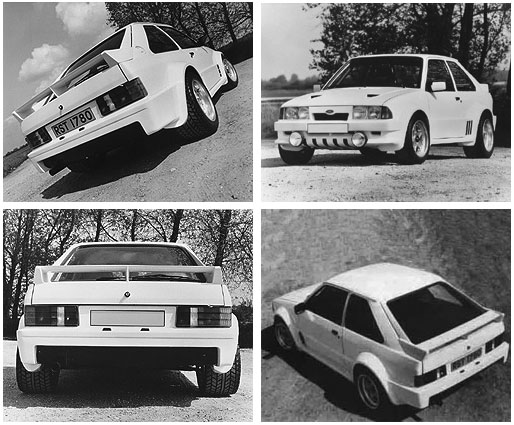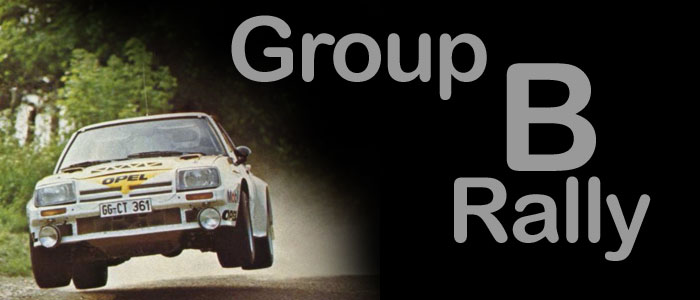1980 Ford RS 1700T

In 1980, following the launch of the MKIII Escort, Ford plans were started to produce a rear wheel drive Escort to replace the MK II Works rally cars, the RS1700T, with a full programme expected in 1983. As all Ford rally enthusiasts will know, the development was hindered by all kinds of problems, and ultimately the project in the UK was cancelled. This is not to imply that the car was un-important to the development of Group B. The Escort 1700T was unofficially the first true silhouette Group B rally car, predating even the Lancia 037. Without the pioneers that cooked this up we might never have had some of the wildest rally cars in history.
Ford Germany had initiated the development of a MkIII Escort with a view to circuit racing, and produced the RS1600i. Right hand drive versions were completed in late 1982, and homologated on January 1st 1983.
Peter Ashcroft announced the decision to run a limited program of Rally events with the GpA RS1600i, for contracted driver Malcolm Wilson, and the up and coming Louise Aitken. However, due to the commitments of Fords Rally HQ at Boreham with the RS1700T, the program was passed over to MCD of Widnes (later to become Rally Engineering Developments or R.E.D.), fresh from their success with Ari Vatanen in 1982.
- Homologation: None - Prototype (18 Produced)
- Layout: Front Engine (longitudinal), RWD
- Top Speed: 140 mph
- 0-60 mph: 4.2s
- Engine: 1778cc Inline 4 cylinder (Aluminum Cosworth BDT)
- Head: DOHC 16 valve
- Power: 350hp
RED took delivery of the first vehicle on Christmas Eve 1982, and had to have both cars built and ready for the first round of the British Rally Championship, the Mintex, on Feb 25th - a tall order by anyone's standards.
The Ford Escort RS 1700T was under development for 2 years. The plans for the 1700T were to be the successor to the ultra successful Mk2 Escort RS1800. The RS1700T was to be entered into the up and coming Group B category for the World Rallying Championship.
The RS 1700T Program was canceled along with the C100 Sports car project when Stewart Turner was offered control of Ford Motorsport for the Second time. This gave rise to one of Ford greatest cars the RS 200. This car to showed promise, and could of well have blitzed the World Rally scene. The group "B" category of cars was closed in the mid 80's. Most of the 18 RS 1700T examples were crushed, but a few remain.

Info copied from www.rsownersclub.co.uk
1985 Ford RS200

- Homologation: 01.02.1986 (B280)
- Double wishbone, twin damper suspension.
- Front remote mounted gearbox
- Center Diff: Viscous coupled RWD/4WD
37% front/63% rear torque split - 50/50 when locked - Top Speed: 140 mph (Road)
- 0-60 mph: 6.0s (Road) - 3.07s (Evo)(World Record)
- Engine: 1804cc (Road) - 2100cc (Evo) (Cosworth BDT)
- Head: DOHC 16 valve
- Fuel: Ford EEC-IV management.
- Induction: Forced (Garrett Turbo)
- Power: 250 bhp (Road) - 650 bhp (Evo)
Ford decided to make road-going versions of the RS200 available to the public, and the car would be produced in sufficient numbers to make a profit. Filippo Sapino of Ghia Design Stuidos in Turin was commissioned to design the body of the car, and the result was a stylish new Group B contender which would also appeal to the masses as a marketable car. Reliant engineering was produced the composite bodywork: fiber glass for street cars Kevlar for race cars. Ford chose former Formula One designer Tony Southgate to engineer the chassis. The car had several features common among other Group B cars, such as four-wheel-drive, a space frame, mid-engine layout, and kevlar bodywork. However, the RS200 had some unique features, such as adjustable torque split, dual shocks on each corner, and an engine tuned by Bryan Hart, a well-known engine supplier of various F1 teams throughout the 1990s. The 4-cylinder, 16 valve engine was quoted as having over 500 hp, and crash test footage showed that the car was extremely strong. The RS200 wasn't entirely perfect; it did have one significant flaw: it was heavier than its rivals.
The RS200 had a brief rally career. The factory team withdrew immediately following the death of Henri Toivonen, and the remaining rally cars were sold off to help recover Ford's investment. The "evolution" version of the RS200 in the works was much lighter and more powerful than the original RS200, and, had Ford had a chance to use it, the RS200 could have been one of the best.
More Specifications: 1985 1986
Mach 2 Ford RS200e

- Homologation - Not Applicable
- Weight: 920 kgs (2028 lbs)
- 0-60 mph: Under 2s)
- Top Speed: 140mph (Reached in under 6s)
- Engine: 2100cc Inline 4 cylinder (Coworth BDT)
- Head: DOHC 16 valve
- Fuel: Pectel T6
- Induction: Forced (30psi boost)
- Power: 840hp
- Torque: 700 ft/lbs @ 7500rpm
This info was pulled from Mach 2's own site: www.mach2racing.com
Our machine started life as a Group B Rally Car. This category was introduced to produce competition between the fastest rally machinery in the world. During the early 80s, when the car was conceived, manufacturers were obliged to produce 200 road cars in order to run in the World Rally Series. Then disaster. In 1986 Group B cars were deemed too fast to race, and Ford were left with the best rally car in the world....but nowhere to race it.
After the demise of Group B, manufacturers interest in them came to an abrupt halt an expensive loss, as Ford had spent around $20 million in development. However privateers still wanted the car for Rallycross, Sprints and Tarmac Hill-Climbs. So enter F1 engine builder Geoff Page of Mountune Racing and GT racer and race car builder Colin Blower of Colin Blower Motorsport.
The RS200E holds the 0-60 mph World Record for a road car at 3.07 seconds thus a good marque to use as a base. It didn't take long for Mach 2 Racing to select Geoff as the engine builder and Colin as the Constructor. Nobody else came close in their respective fields. Unhampered by fuel restrictions we have what we believe to be the fastest off-road racer of all time.
Is it really 840 bhp ?? In early 1998 our road car was stripped to its last nut and bolt, lightened, modified and reassembled. A BDT Evolution 840 bhp engine was prepared by F1 engine constructor Geoff Page, who has assembled the engines for almost all the competition RS 200s ever built. There are only a handful of specialists in the world who can build these engines, and Geoff is the best of the best. Running on 118 octane fuel produces extra power by way of advanced ignition timing, and this engine is the most powerful Geoff has ever prepared. It runs at 2 bar boost , and produces 840 bhp and 700 ft lbs of torque 7500 rpm. The secret is in its power delivery. The engine is controlled by a Pectel T6 management system which controls the boost as the car ascends to 14,000 ft. It also boasts a sophisticated anti-lag system to aid 'driveability' This is no 'on or off' engine that bedeviled the Group B cars of the 1980s. We have power and control.
